
An eductor is a cleverly designed pump that operates based on the Venturi effect. Unlike more complex pumps with mechanical components, eductors have no moving parts. Instead, they rely on fluid dynamics principles to transfer liquids, gases, or air from one location to another. Let’s dive deeper into how they work and their applications on ships.
Bernoulli’s Principle and the Venturi Effect
Before we delve into eductors, let’s understand the underlying principles:
- Bernoulli’s Principle: According to classical fluid mechanics, Bernoulli’s principle states that changes in fluid velocity result in pressure differentials within an incompressible fluid system. It accounts for variations in potential energy due to fluid motion. Venturi Effect: A specific case of Bernoulli’s principle, the Venturi effect occurs when fluid passes through a narrowed cross-sectional area. As the area decreases, fluid velocity increases, leading to a drop in static pressure. This effect is demonstrated by a Venturi meter.
How Eductors Work
Eductors, also known as jet pumps, utilize the Venturi effect. Here’s how they operate:
- Inlet Nozzle: A driving or motive fluid (usually water) enters through a tapering inlet nozzle. This fluid is drawn from another pump or flow source. Pressure Drop and Velocity Increase: As the fluid exits the nozzle, its cross-sectional area decreases, causing a rise in flow velocity. Consequently, there’s a decrease in pressure due to the Venturi action.
- Suction Effect: In the wake of the low-pressure zone created by the driving fluid, another fluid (the suction fluid) is drawn in from a separate inlet opening. For the suction fluid to be drawn in, the pressure created by the driving fluid must be lower than that of the suction fluid.
- Energy Transfer: The two fluids mix in the throat section, with the suction fluid gaining kinetic energy. The mixture then moves to the diffuser section, where the cross-sectional area increases again. Velocity decreases, and pressure energy increases.
- Fluid Ejection: The resultant fluid (a combination of driving and suction fluids) is ejected at a definite outlet.

Applications on Ships
Eductors find various applications aboard ships:
- Stripping Tanks: Eductors are used for stripping tanks. Since they have no moving parts, they are easy to maintain. The driving fluid (usually from the main cargo pump) creates a vacuum on the suction side, allowing efficient tank stripping.
- Hazardous Areas: Eductors require only a motive fluid for operation, making them suitable for use in hazardous areas.